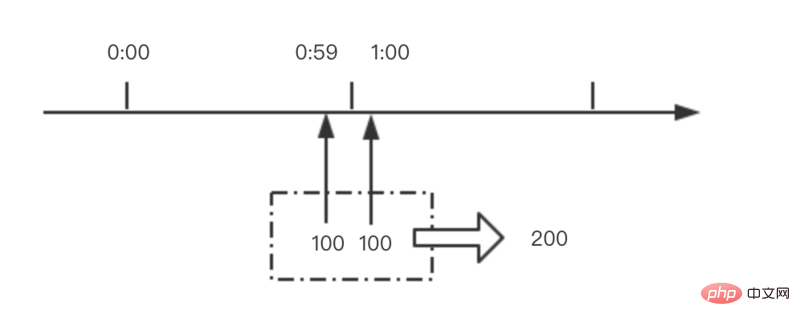1. Overview
The allocation algorithm currently supported by Nginx's upstream:
1. Round-robin polling 1:1 to process requests in turn (default)
Each request is processed one by one in chronological order Assigned to different application servers, if the application server goes down, it will be automatically removed, and the remaining ones will continue to be polled.
2. Weight weight (weighted polling)
By configuring the weight, the polling probability is specified. The weight is proportional to the access ratio and is used for uneven performance of the application server.
3. ip_hash hash algorithm
Each request is allocated according to the hash result of the accessed IP, so that each visitor has a fixed access to an application server, which can solve the problem of session sharing. If the application server fails, it needs to be shut down manually.
Parameter meaning:
down: Indicates that the previous server will not participate in the load temporarily
weight: The default is 1. The greater the weight, the greater the weight of the load.
max_fails: The number of allowed request failures defaults to 1. When the maximum number is exceeded, the error defined by the proxy_next_upstream module is returned.
fail_timeout: The pause time after max_fails failures.
backup: When all other non-backup machines are down or busy, request the backup machine.
2. Configuration


upstream tg-t4 {
server 10.0.0.110:8099;
server 10.0.0.110:8098;
}
server {
listen 8096;
server_name www.tg-t4.com;
location / {
proxy_pass http://tg-t4;
}
}
Access result: ABABABABA2, Weighted pollingupstream tg-t4 {
server 10.0.0.110:8099 weight=2;
server 10.0.0.110:8098 weight=5;
}
server {
listen 8096;
server_name www.tg-t4.com;
location / {
proxy_pass http://tg-t4;
}
}
Access result: ABBABB ABBABB Note: The access result affected by weight is calculated based on the minimum proportion, not the ideal Status: AABBBBB AABBBBB3, ip_hashupstream tg-t4 {
server 10.0.0.110:8099;
server 10.0.0.110:8098;
ip_hash;
}
server {
listen 8096;
server_name www.tg-t4.com;
location / {
proxy_pass http://tg-t4;
}
}
Access result: IP1:AAAAAAIP2:BBBBBB4, Hot standbyupstream tg-t4 {
server 10.0.0.110:8099;
server 10.0.0.110:8098 backup;
}
server {
listen 8096;
server_name www.tg-t4.com;
location / {
proxy_pass http://tg-t4;
}
}
Access result:Access 1: Both services are normal. AAAAAAAccess 2: Deactivated 10.0.0.110:8099. BBBBBBAccess 3: Restart 10.0.0.110:8099. AAAAAA5. Add parameter optimizationupstream tg-t4 {
server 10.0.0.110:8099 weight=1 max_fails=2 fail_timeout=2;
server 10.0.0.110:8098 weight=3 max_fails=2 fail_timeout=2 backup;
}
server {
listen 8096;
server_name www.tg-t4.com;
location / {
proxy_pass http://tg-t4;
}
}
Access results: Same as 4backup has the highest priority. When this parameter is set, the corresponding service can only As a hot standby. The above is the detailed content of How to implement load balancing polling configuration in nginx. For more information, please follow other related articles on the PHP Chinese website!
 内存飙升!记一次nginx拦截爬虫Mar 30, 2023 pm 04:35 PM
内存飙升!记一次nginx拦截爬虫Mar 30, 2023 pm 04:35 PM本篇文章给大家带来了关于nginx的相关知识,其中主要介绍了nginx拦截爬虫相关的,感兴趣的朋友下面一起来看一下吧,希望对大家有帮助。
 nginx限流模块源码分析May 11, 2023 pm 06:16 PM
nginx限流模块源码分析May 11, 2023 pm 06:16 PM高并发系统有三把利器:缓存、降级和限流;限流的目的是通过对并发访问/请求进行限速来保护系统,一旦达到限制速率则可以拒绝服务(定向到错误页)、排队等待(秒杀)、降级(返回兜底数据或默认数据);高并发系统常见的限流有:限制总并发数(数据库连接池)、限制瞬时并发数(如nginx的limit_conn模块,用来限制瞬时并发连接数)、限制时间窗口内的平均速率(nginx的limit_req模块,用来限制每秒的平均速率);另外还可以根据网络连接数、网络流量、cpu或内存负载等来限流。1.限流算法最简单粗暴的
 nginx+rsync+inotify怎么配置实现负载均衡May 11, 2023 pm 03:37 PM
nginx+rsync+inotify怎么配置实现负载均衡May 11, 2023 pm 03:37 PM实验环境前端nginx:ip192.168.6.242,对后端的wordpress网站做反向代理实现复杂均衡后端nginx:ip192.168.6.36,192.168.6.205都部署wordpress,并使用相同的数据库1、在后端的两个wordpress上配置rsync+inotify,两服务器都开启rsync服务,并且通过inotify分别向对方同步数据下面配置192.168.6.205这台服务器vim/etc/rsyncd.confuid=nginxgid=nginxport=873ho
 nginx php403错误怎么解决Nov 23, 2022 am 09:59 AM
nginx php403错误怎么解决Nov 23, 2022 am 09:59 AMnginx php403错误的解决办法:1、修改文件权限或开启selinux;2、修改php-fpm.conf,加入需要的文件扩展名;3、修改php.ini内容为“cgi.fix_pathinfo = 0”;4、重启php-fpm即可。
 如何解决跨域?常见解决方案浅析Apr 25, 2023 pm 07:57 PM
如何解决跨域?常见解决方案浅析Apr 25, 2023 pm 07:57 PM跨域是开发中经常会遇到的一个场景,也是面试中经常会讨论的一个问题。掌握常见的跨域解决方案及其背后的原理,不仅可以提高我们的开发效率,还能在面试中表现的更加
 nginx部署react刷新404怎么办Jan 03, 2023 pm 01:41 PM
nginx部署react刷新404怎么办Jan 03, 2023 pm 01:41 PMnginx部署react刷新404的解决办法:1、修改Nginx配置为“server {listen 80;server_name https://www.xxx.com;location / {root xxx;index index.html index.htm;...}”;2、刷新路由,按当前路径去nginx加载页面即可。
 Linux系统下如何为Nginx安装多版本PHPMay 11, 2023 pm 07:34 PM
Linux系统下如何为Nginx安装多版本PHPMay 11, 2023 pm 07:34 PMlinux版本:64位centos6.4nginx版本:nginx1.8.0php版本:php5.5.28&php5.4.44注意假如php5.5是主版本已经安装在/usr/local/php目录下,那么再安装其他版本的php再指定不同安装目录即可。安装php#wgethttp://cn2.php.net/get/php-5.4.44.tar.gz/from/this/mirror#tarzxvfphp-5.4.44.tar.gz#cdphp-5.4.44#./configure--pr
 nginx怎么禁止访问phpNov 22, 2022 am 09:52 AM
nginx怎么禁止访问phpNov 22, 2022 am 09:52 AMnginx禁止访问php的方法:1、配置nginx,禁止解析指定目录下的指定程序;2、将“location ~^/images/.*\.(php|php5|sh|pl|py)${deny all...}”语句放置在server标签内即可。


Hot AI Tools

Undresser.AI Undress
AI-powered app for creating realistic nude photos

AI Clothes Remover
Online AI tool for removing clothes from photos.

Undress AI Tool
Undress images for free

Clothoff.io
AI clothes remover

AI Hentai Generator
Generate AI Hentai for free.

Hot Article

Hot Tools

SublimeText3 Mac version
God-level code editing software (SublimeText3)

MantisBT
Mantis is an easy-to-deploy web-based defect tracking tool designed to aid in product defect tracking. It requires PHP, MySQL and a web server. Check out our demo and hosting services.

MinGW - Minimalist GNU for Windows
This project is in the process of being migrated to osdn.net/projects/mingw, you can continue to follow us there. MinGW: A native Windows port of the GNU Compiler Collection (GCC), freely distributable import libraries and header files for building native Windows applications; includes extensions to the MSVC runtime to support C99 functionality. All MinGW software can run on 64-bit Windows platforms.

WebStorm Mac version
Useful JavaScript development tools

Safe Exam Browser
Safe Exam Browser is a secure browser environment for taking online exams securely. This software turns any computer into a secure workstation. It controls access to any utility and prevents students from using unauthorized resources.







